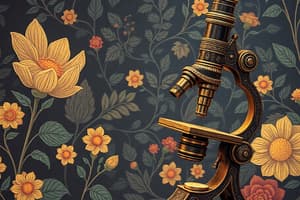Podcast
Questions and Answers
What is the function of the arm (or neck) of a microscope?
What is the function of the arm (or neck) of a microscope?
- Contains the objective lenses
- Adjusts the light intensity
- Supports the microscope when carried (correct)
- Holds the slides in place
What does the coarse adjustment knob do?
What does the coarse adjustment knob do?
Moves the stage up and down to help get the specimen into view.
What part of the microscope supports it?
What part of the microscope supports it?
- Stage
- Arm (correct)
- Eyepiece
- Base (correct)
How is magnification power measured?
How is magnification power measured?
What is the power of eyepiece lenses usually?
What is the power of eyepiece lenses usually?
What does the rotating/revolving nosepiece do?
What does the rotating/revolving nosepiece do?
What does the light source do?
What does the light source do?
Where should you place the slide on a microscope?
Where should you place the slide on a microscope?
Always carry the microscope by holding the ______ of the microscope with one hand and supporting the base with the other hand.
Always carry the microscope by holding the ______ of the microscope with one hand and supporting the base with the other hand.
What should you use to clean the microscope lenses?
What should you use to clean the microscope lenses?
What happens to the slide when the stage is moved up towards the slide?
What happens to the slide when the stage is moved up towards the slide?
Flashcards
Arm (or Neck)
Arm (or Neck)
Supports the microscope when carried, acts as a handle.
Base
Base
The bottom part of the microscope that supports the entire structure.
Coarse Adjustment Knob
Coarse Adjustment Knob
Moves the stage up and down to bring the specimen into view, used with low power only.
Eyepiece
Eyepiece
Signup and view all the flashcards
Fine Adjustment Knob
Fine Adjustment Knob
Signup and view all the flashcards
Light (or Light Source)
Light (or Light Source)
Signup and view all the flashcards
Objective Lenses
Objective Lenses
Signup and view all the flashcards
Total Magnification
Total Magnification
Signup and view all the flashcards
Diaphragm
Diaphragm
Signup and view all the flashcards
Stage
Stage
Signup and view all the flashcards
Cleaning the Lenses
Cleaning the Lenses
Signup and view all the flashcards
Study Notes
Compound Microscope Parts
- Arm (or Neck): Supports the microscope when carried, serves as a handle.
- Base: The bottom part of the microscope, supports the entire microscope.
- Coarse Adjustment Knob: Moves the stage up and down to help get the specimen into view, only used with low power objective.
- Eyepiece: The lens at the top of the microscope, contains the ocular lens, magnifies the image for the viewer.
- Fine Adjustment Knob: Finely focuses low and high power objectives, moves the tube up and down slightly.
- Light (or Light Source): Provides light to view the specimen, projects light upwards through the diaphragm.
- Objective Lenses: Adjustable lens system, ranges from low to high power, usually 2-4 lenses on a microscope.
- Ocular Lens: Contains a lens to magnify an image 10x (sometimes 15x), projected by the objective lens.
- Rotating/Revolving Nosepiece: Holds the objective lens, can be rotated to change the magnification.
- Stage: Supports the slide, platform for the slide to rest, has an opening in its center that lets light pass through.
- Stage Clips: Holds the slides in place on the stage for viewing.
- Tube/Body Tube: Connects the eyepiece to the objective lenses, allows the image and light to reach the eyepiece.
Microscope Functions
- Magnification Power: Refers to the amount of magnification for each lens, marked by a number with an X next to it.
- Total Magnification: Ocular Lens Magnification x Objective Lens Magnification.
- Diaphragm: Adjusts the amount of light that reaches the specimen, contains a dial that rotates.
- Slide Adjustment Knobs: Adjusts the position of the slide on the stage.
Using the Microscope
- Carrying the Microscope: Always carry the microscope by the arm with one hand and supporting the base with the other hand.
- Placing the Microscope: Place the microscope on a flat, sturdy surface, with the arm positioned towards you.
- Focusing the Image: Always focus first using the coarse adjustment knob and the low-power objective lens, then use the fine adjustment knob to sharpen the image.
- Switching Objective Lenses: Switch to the medium-power or high-power objective, use only the fine adjustment knob to focus the image.
Maintenance
- Cleaning the Lenses: Use lens tissue to clean the microscope lenses, lens tissue has been treated to prevent scratching.
Studying That Suits You
Use AI to generate personalized quizzes and flashcards to suit your learning preferences.




